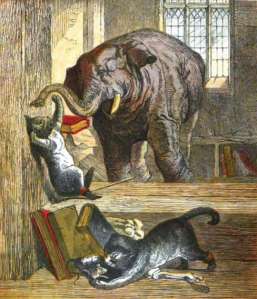1001 Nights or in English speaking world more known as Arabian Nights is one of the most influential books in our history.
Let’s start with some Public Domain images from beautiful site karenswhimsy.com:

Six color plates from Arabian Nights
Unfortunately illustrator is not known (pretty often situation in 19th century). If somebody knows at least what is the title of the book, please let me know in the comments section.
In the mean time there are some other beautiful scenes from this amazing collection…
Let me start with amazing artist who died too young: Virginia Frances Sterrett (born 1900, died 1931) who illustrated only three books in her life but made huge impact in the history of illustration. Arabian Nights is her second book nd it is still available as so called restored version by Mediaamorphosis, publishing house from Bucharest.
Next set of illustrations is available through one more amazing site with big hearted enthusiast behind.
Site is called http://www.artpassions.net/ and I highly recommend it for all lovers of HQ illustrations. Here we go:

Virginia Frances Sterrett – Arabian Nights (9 color plates)
and another set:

Virginia Frances Sterrett – Arabian Nights (5 color plates)
Amazing colors, right?
Here is another fascinating book titled The Arabian Nights’ Entertainments, published in New York by Harper & Brothers around 1916. It is illustrated by Louis Rhead, born 1857 and died 1926, what makes illustrations Public Domain in European Union on terms author’s life + 70 years.

Arabian Nights Entertainment by Louis Rhead
Who’s afraid of the powerful Jinn?
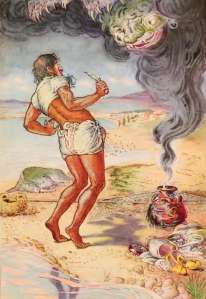
At the appearance of this huge monster the fisherman wished to run away
This is a world of magic.

The old man began to sing after his own manner and to sway to and fro on my shoulders
Did you recognize the scene from one of the Sinbad’s seven voyages?
What about next one?

The magician persisted in demanding the lamp before he helped Aladdin out of the cave
O.k., you got it! But did you know the tale about Aladdin and the magic lamp belongs to so called orphan tales of Arabian Nights? Nobody ever found any manuscript proving its origins and there is great possibility it is written by Antoine Galland (born 1646, died 1715), French translator who brought this wonderful tales to Europe?
Shall we check some illustrations by Walter Paget (born 1863, died 1935)?
This book was published by : E. Nister in London and E.P. Dutton in New York around 1907. It contains only eight stories:
1. The Merchant and the Genie
2. The Story of the Fisherman
3. The Enchanted Horse
4. The Story of Aladdin or The Wonderful Lamp
5. Ali Baba
6. The Story of Kummir Al Zumman and Badoura, Princess of China
7. Sindbad the Sailor
8. The story of the Little Hunchback
Here is my selection of color illustrations:

Scheherazade

The story of the fisherman

The enchanted horse

Aladdin

Ali Baba

Sindbad the sailor
Pretty cool stuff, huh?
Let’s take a look at a The stories for Arabian Nights Entertainments, published by Longmans, Green, and Co.,
London in 1898. This book was heavily revisited and adapted by Andrew Lang to make it suitable for children. If you didn’t know, 1001 Nights is pretty saucy collection with many adult themes (unfaithful wives are just everywhere and they enjoy their perils in every possible way), so if the publishers wanted to present the book to children, a lot of editing was a must. Lang’s edition lost a lot of charm because cuts were made just too fast and without the feeling for the story.
But we can still enjoy the illustrations, right?
These are work of Rene Bull, Irish illustrator born in 1872 and died in 1942:














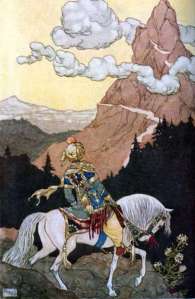
This book is collaboration of Henry Justice Ford who did black and white illustrations and Rene Bull who made the 15 color plates above. But Andrew Lang made more editions and I found one from 1929 where Henry Justice Ford (born 1860, died 1941) made some color full size illustrations too. Here they are:
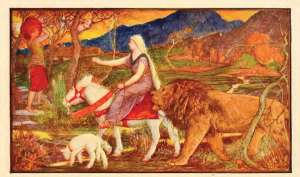
Thus they rode all day

The genius commands they young man to slay the princess

The end of the dragon

The prince and the princess arrive at the capital of Persia on the enchanted horse
And now a great project from Raphael Tuck & Sons with American illustrators Will and France Brundage:









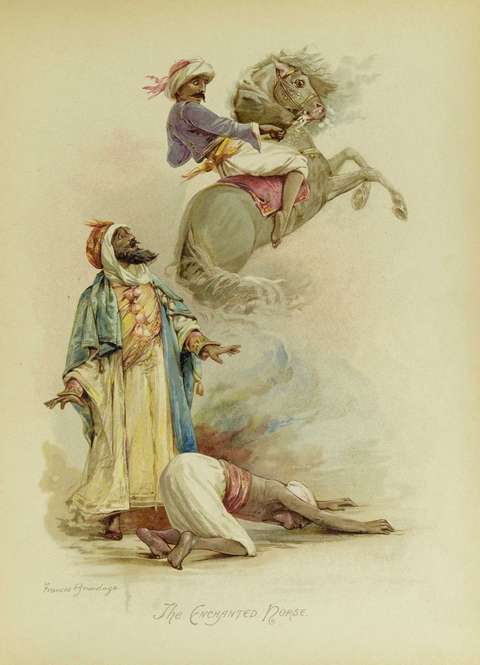


More about the book you can find here.
Are they great or what?
Ladies and gentelmen – salute to illustrations from Arabina Nights aka 1001 Nights!









